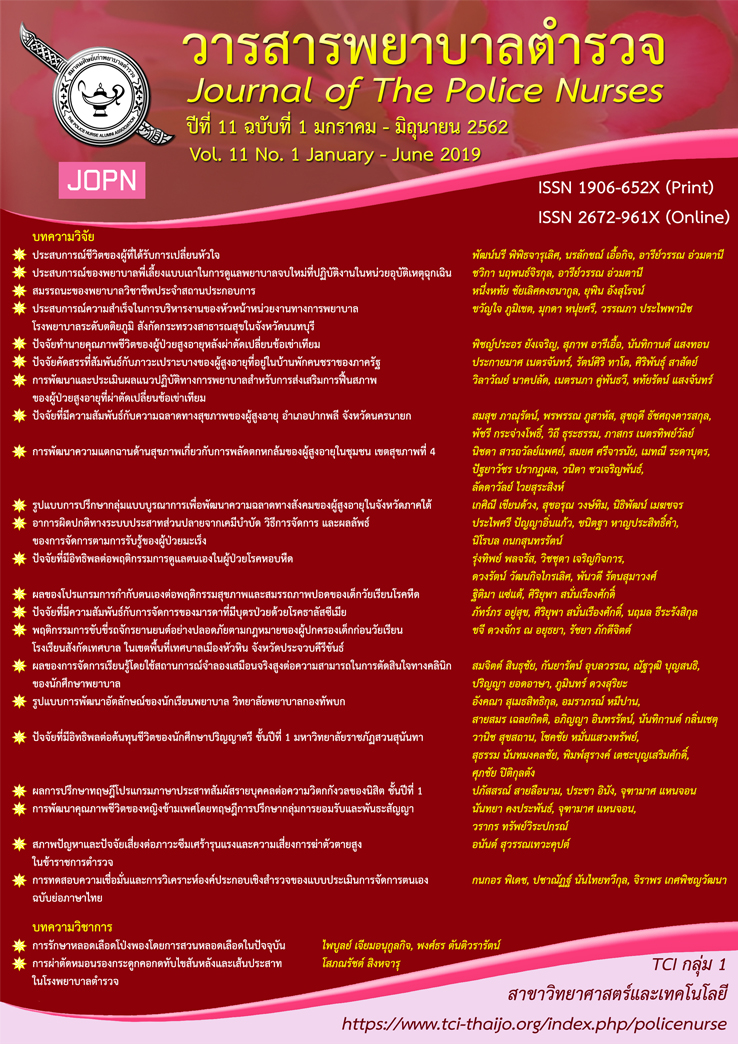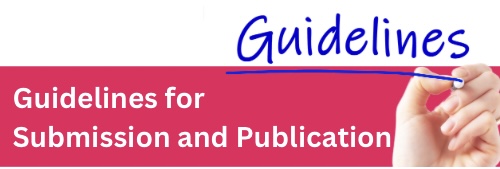EFFECT OF HIGH FIDELITY SIMULATION BASED LEARNING ON CLINICAL DECISION MAKING ABILITY OF NURSING STUDENTS
Effect of High Fidelity Simulation Based Learning on Clinical Decision Making Ability of Nursing Students
Keywords:
high fidelity simulation based learning, clinical decision making abilityAbstract
This mixed-method research used quantitative research as a major method and qualitative research as a minor method to determine the effect of high fidelity simulation based learning on clinical decision making ability of nursing students. The study population consisted of 91 junior nursing students who studied Nursing Care of Persons with Health Problems in Practicum III in the Bachelor of Nursing Science Program of Boromarajonani College of Nursing, Saraburi. The simple random sampling was used to recruit 39 students into a treatment group which was taught using the high fidelity simulation based learning, including 4 situations; and each situation took 60 minutes. The instrument used in this study consisted of the clinical decision making ability tests including 4 situations. Each situation evaluated the 4 steps of the clinical decision making ability 1) data collection ability, 2) data interpretation and problem identification ability, 3) clinical decision making ability, and 4) clinical practice evaluation ability. The data analysis was done using the descriptive statistics of percentage, mean, standard deviation, and dependent t-test.
The results of this study were as follows: 1) Mean score of clinical decision making ability in the treatment group after the experiment was significantly higher than the one before experiment at the statistical level of .05. 2) The results of the focus group showed the following data about clinical decision making ability: (1) assessment, the students saw more importance of assessment, learned the mistakes from assessment to apply in a new situation, and thought that pathophysiology knowledge will help them to complete patient assessment. (2) Data interpretation and problem identification, interpretation collected the needed data to know the normal values of the results of laboratory tests, understand pathophysiology, and know which data are important to identify problems and causes of patients. The ability of data interpretation helped nurses to provide correct treatment and nursing care and appropriate to patients’ problems. (3) Clinical decision making helped students to practice analytic thinking, decision making, grading the importance of nursing care, understanding the decision making and nursing roles as well as developing decision making, providing causes of nursing practice, and providing medicine. (4) Clinical practice evaluation, the students realized the important data that were evaluated after provided nursing care. The results of this study can be used for promoting high fidelity simulation based learning to develop clinical decision making ability of nursing students.
Downloads
References
Adamson, K., Gubrud, P., Sideras, S., & Lasater, K. (2012). Assessing the reliability, validity and use of the Lasater clinical judgment rubric: Three approaches. Journal of Nursing Education, 51, 66-73.
Alden, K. R., & Durham, C. F. (2012). Integrating in simulation: Structure, content, and processes. In G. D. Sherwood & S. Horton-Deutsch (eds.), Reflective practice: Transforming education and improving outcomes (pp.149-165). Indianapolish: Sigma Theta Tau International.
Alfaro-Lefevre, R. (2013). Critical thinking critical reasoning and clinical judgement (5th ed.).
St. Louise: Sauders Elsevier.
AL Sabe, S. D., & Lasater, K. (2016). Simulation debriefing for clinical judgment development: A concept analysis. Nurse Education Today, 45, 42–47.
Ashley, J., & Stamp, K. (2014). Learning to think like a nurse: The development of clinical judgment in nursing students. Journal of Nursing Education, 53(9), 519–525.
Bjork, I. T., & Hamilton, G. A. (2011). Clinical decision making of nurses working in hospital settings. Nursing Research and Practice, doi.org/10.1155/2011/524918.
Boromarajonani College of Nursing Saraburi. (2016). Report of six domains of learning evaluate of graduated student in academic year. Boromarajonani College of Nursing Saraburi.
Burn, N., & Grove, S. K. (2005). The practice of nursing research conduct, critique and utilization (5th ed.). Philadelphia. W.B.Saunders.
Bussard, M. E. (2015). Clinical judgment in reflective journals of prelicensure nursing students. Journal of Nursing Education, 54(1), 36–40.
Bussard, M. E. (2017). Postdebriefing activities following simulation. Teaching and Learning in Nursing, 12, 220–222.
Cappelletti, A., Engel, J., & Prentice, D. (2014). Systematic review of clinical judgment and reasoning in nursing. Journal of Nursing Education, 53(8), 453–458.
Decker, S., Fey, M., Sideras, S., Caballero, S., Rockstraw, L., Boese, T., … & Borum, J. C. (2013). Standards of best practice: Simulation standard VI: The debriefing process. Clinical Simulation in Nursing, 9(6), S26-S29.
Edelen, G. B., & Bell, A. A. (2011). Role of an analogy-guide learning experiences in enhancing students’s clinical decision making skill. Journal of Nursing Education, 50(8), 453-460.
Faul, F., Erdfelder, E., Lang, A. G., & Buchuer, A. (2007). G* power 3: A flexible statistical power analysis program for the social, behavioral, and biomedical sciences. Behavioral Research Methodology, 39, 175-191.
Fawaz, M. A., & Hamdan-Mansour, A. M. (2016). Impact of high-fidelity simulation on the development of clinical judgment and motivation among Lebanese nursing students. Nurse Education Today, 46, 36–42.
Forneris, S. G., Neal, D. O., Tiffany, J., Kuehn, M. B., Meyer, H. M., Blazovich, L. M., ... & Smerillo, M. (2015). Enhancing clinical reasoning through simulation debriefing: A multisite study. Nursing Education Perspectives, 36(5), 304–310.
Grove, S., Burns, N., & Gray, J. (2013). The practice of nursing research: appraisal, synthesis, and generation of evidence (7th ed.). St. Louis, MO: Saunders.
Hallin, K., Backstrom, B., Haggstrom, M., & Kristiansen, L. (2016). High-fidelity simulation: Assessment of student nurses' team achievements of clinical judgment. Nurse Education in Practice,19, 12-18.
Jefferies, P. R. (2005). A framework for designing, implementing, and evaluating simulations used as teaching strategies in nursing. Nursing Education Perspectives, 26, 96-103.
Jensen, R. (2013). Clinical reasoning during simulation: Comparison of student and faculty ratings, Nurse Education in Practice, 13, 23-28.
Kantar, L., & Alexander, R. (2012). Integration of clinical judgment in the nursing curriculum: Challenges and perspectives. Journal of Nursing Education, 51(8), 444-453.
Kolb, A. Y., & Kolb, D. A. (2005). Learning styles and learning spaces: Enhancing experience learning in higher education. Academic Management Learning Education, 4(2), 193-213.
Landeen, J., Pierazzo, J., Akhtar-Danesh, N., Baxter, P., van Eijk, S., & Evers, C. (2015). Exploring student and faculty perceptions of clinical simulation: A Q-sort study. Journal of Nursing Education, 54(9), 485–491.
Lasater, K., Nielsen, A. E., Stock, M., & Ostrogorsky, T. L. (2015). Evaluating the clinical judgment of newly hired staff nurses. Journal of Continuous Education Nursing, 46(12), 563-571.
Lee, J., & Oh, P. (2015). Effects of the use of high-fidelity human simulation in nursing education: A meta-analysis. Journal of Nursing Education, 54(9), 501–507.
Lisko, S. A., & O’Dell, V. (2010). Integration of theory and practice: Experiential learning theory and nursing education. Nursing Education Perspectives, 31, 106-108.
Poungjuntarade, N., & Pleankaew, P. (2016). Factors related to nursing students' critical thinking.
Journal of The Police Nurse, 8(1), 125-135.
Ridley, C. R., & Shaw-Ridley, M. (2009). Clinical judgment accuracy: From meta-analysis to meta-theory. The Counseling Psychologist, 37, 400-409.
Rizzolo, M. A., Kardong-Edgren, S., Oermann, M. H., & Jeffries, P. R. (2015). The national league for nursing project to explore the use of simulation for high-stakes assessment: Process, outcomes, and recommendations. Nursing Education Perspectives, 36(5), 299–303.
Seright, T. J. (2011). Clinical decision-making of rural novice nurses. Rural and Remote Health, 11, 1726.
Thailand Nursing and Midwifery Council. (2013). Competencies of Registered Nurses (2nd ed.). Bangkok: Siriyod Printing.
Victor-Chmil, J. (2013). Critical thinking versus clinical reasoning versus clinical judgment: Differential diagnosis, Nurse Educator, 38, 34-36.
Waznonis, A. R. (2014). Methods and evaluations for simulation debriefing in nursing education. Journal of Nursing Education, 53(8), 459–465.
Weaver, A. (2015). The effect of a model demonstration during debriefing on students’ clinical judgment, self-confidence, and satisfaction during a simulated learning experience. Clinical Simulation in Nursing, 11, 20-26.
Downloads
Published
How to Cite
Issue
Section
License
ผลงานที่ได้ตีพิมพ์แล้วจะเป็นลิขสิทธิ์ของวารสารพยาบาลตำรวจ















